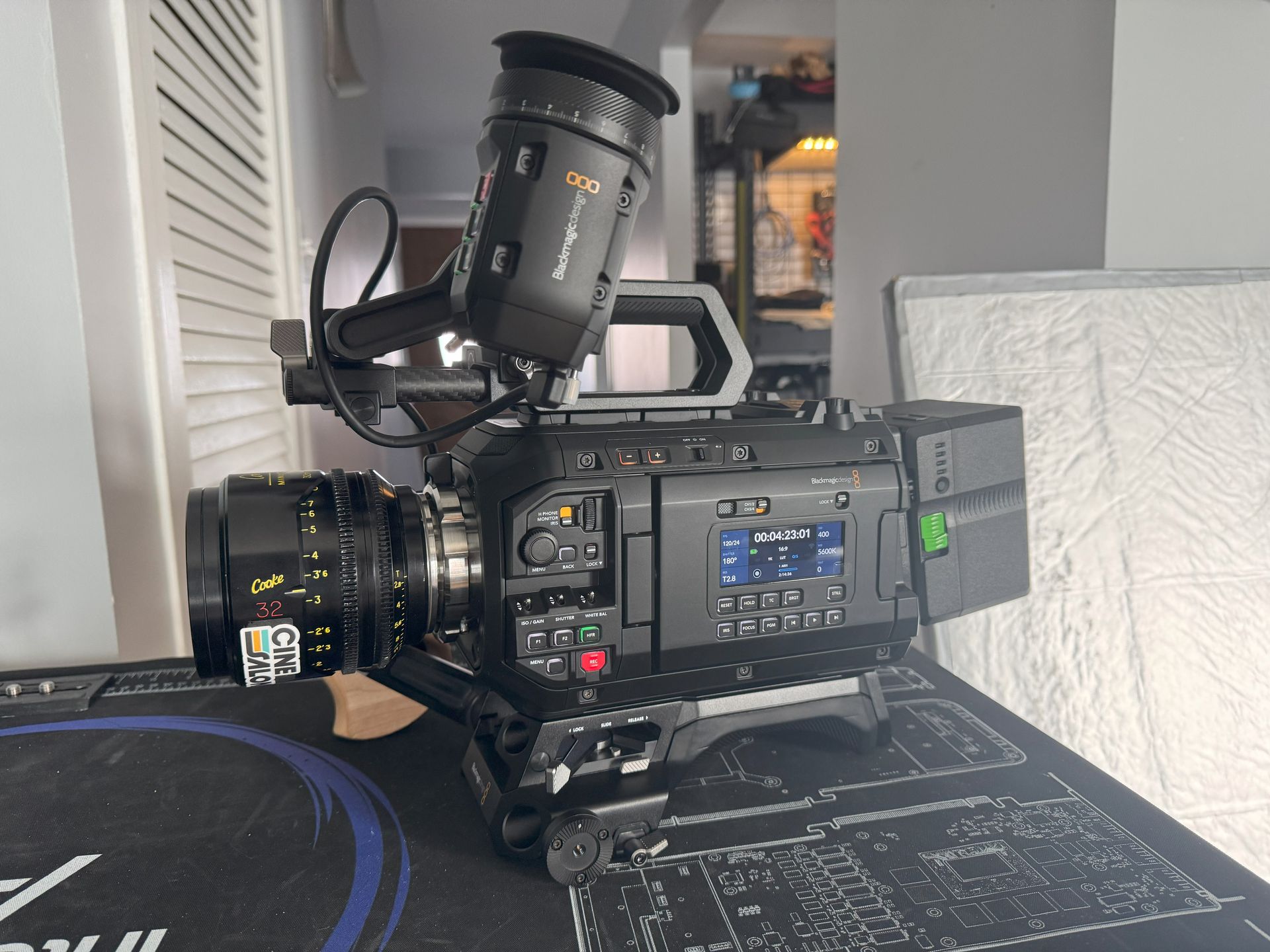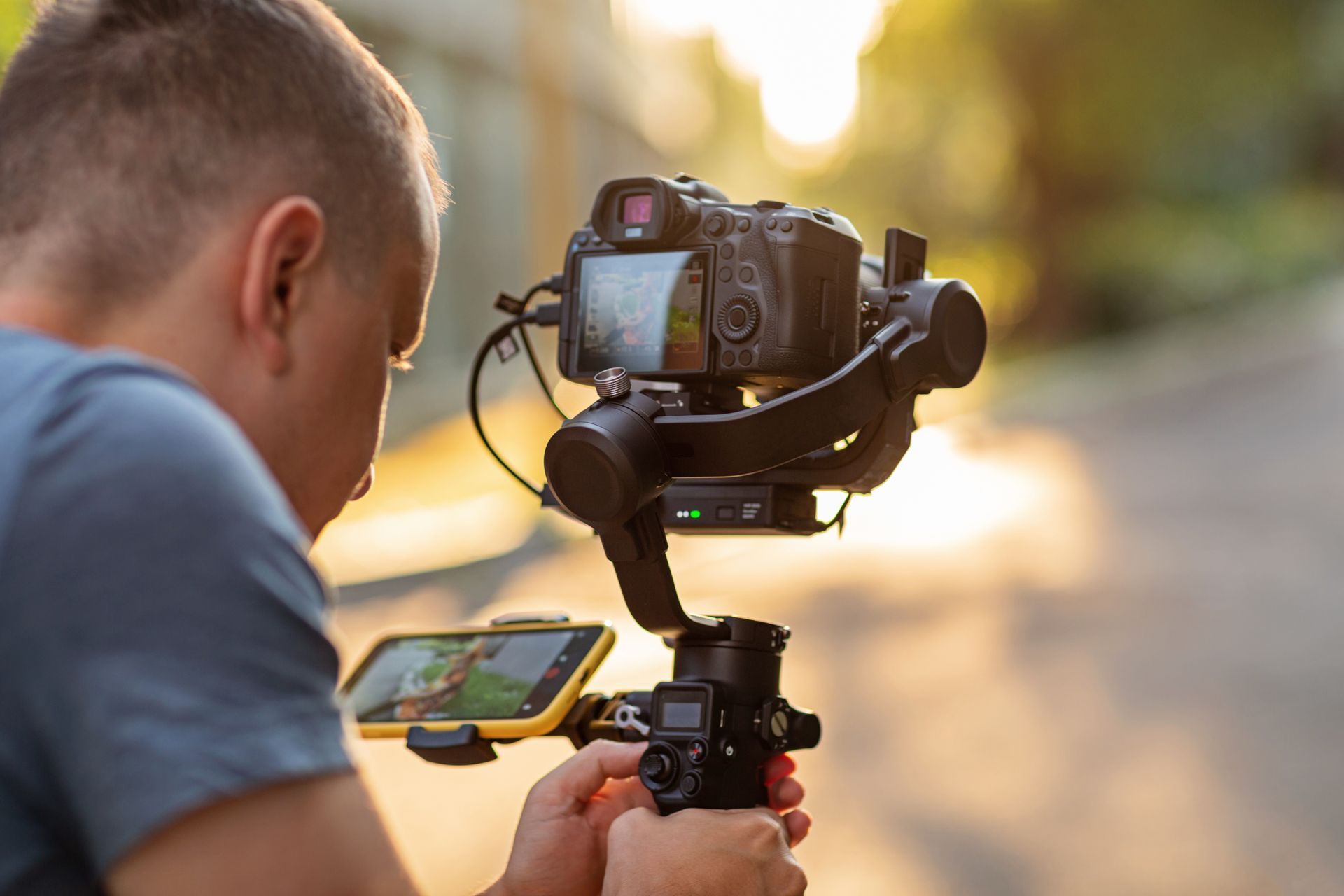Wondering how to outmaneuver your competition with video?
Here, we've compiled an exhaustive list of tried-and-true tactics to get you the results you want.
Are you tired of using the same old written content and images for your marketing strategy?
In 2023, consumers have little time for unoriginal, uninteresting or unengaging material. The emergence of live streaming, 360 videos, VR/AR, and other technologies has contributed to a major shift in consumer preferences.
That's where modern video marketing comes in. A recent study by Wyzowl found that 87% of businesses are using video as a powerful marketing tool. Furthermore, a whopping 91% of marketers consider video to be a crucial component of their marketing strategy. It's clear that video has become a dominant force in the marketing world, as both businesses and marketers recognize its effectiveness in capturing attention and driving results.
Diving head-first into video marketing, however, can be intimidating, regardless of whether you're a beginner or an expert.
Well worry not! This guide is here to help you.

Together, we'll unveil the secrets of successful video marketing, enabling you to find and/or create your perfect piece of video marketing media. We'll also learn how to master the art of strategic distribution to achieve optimal audience engagement.
So, here we go - it's time to step into the spotlight and elevate your marketing game to new heights, with the power of video!
What is a video marketing strategy?
Video marketing is a strategic method used by savvy marketing teams to craft and share videos. The aim is always to captivate and connect with the target audience.
Using visually compelling and easily digestible content, video marketing holds your audience's attention while impactfully delivering your message.
Here are the steps to mastering your video marketing in 2023:
I. Develop a successful video marketing strategy - from concept to distribution
II. Boost Your Website's Visibility with Video and SEO
III. Choose the Right Video Type for Your Brand's Message and Audience
IV. Navigate the three key stages of video production
V. Maximize reach and engagement through effective video distribution strategies
VI. Evaluate the performance and effectiveness of your video content
I. Develop a Successful Video Marketing Strategy - from Concept to Distribution
Creating impactful videos requires careful planning and a clear roadmap. Just like you wouldn't embark on a road trip without a map or go hiking without a trail guide, you shouldn't dive into video marketing without a solid plan.
Think of your strategy as a compass that directs you towards success. It's like planning an exciting adventure where you carefully map out your video marketing goals, budget, timeline, and production processes. Without a clear strategy, you're simply taking shots in the dark and hoping for the best.
Before setting out on your journey to video marketing greatness, make sure you have a well-defined plan in place. This plan will guide you towards your destination and help you achieve your desired results.
When developing your video marketing strategy, ask yourself the following questions:
A. What are your goals?
B. Who is your target audience?
C. What story do you want to tell?
D. What resources do you need to execute your plan?
E. Can you stick to your timeline?
F. How much is your budget?
Now that we're headed in the right direction, let's dive into the details and learn how to excel at every step, just like we'd rock a dance-off routine at a family reunion!

A. What are your goals?
When creating your video marketing plan, it's crucial to outline
your video's goals from the start. Consider the different stages of the marketing funnel and determine which stage is most important for your brand.
Here are the four stages in the video marketing funnel:
1. Capture your viewer's attention
Define a challenge or opportunity that resonates with your audience. Make them realize they have a problem that needs solving. Find ways to pique their interest and drive engagement.
2. Help your viewer find solutions
Your viewers are actively seeking solutions to the problem they're facing. They conduct research, watch product reviews, seek recommendations, and explore cost-effective solutions.
Your videos should provide valuable information, showcase expertise, and highlight how your products or services can address their needs.
3. Convince your viewer to choose you
Now, your viewer is at the decision-making stage. They are narrowing down their options and preparing to make a choice.
This is your chance to shine and make a case for your product. Your videos can provide social proof, customer testimonials, case studies, and other compelling material. These efforts can set you apart from the competition.
Creating your value proposition with the help of a little persuasion can influence your viewer to choose your brand.
4. Wow your customer
Once the viewer becomes a customer, continue to engage them. Create videos featuring customer success stories, provide product usage tips, or offer exclusive discounts for repeat customers. You can also use videos to motivate employees, provide training, and foster a positive work culture.
To maximize the impact of your videos, remember their versatility in delighting customers and communicating with your team.
B. Who is your target audience?
Building on the previous point, consider the following when defining your target audience:
- Identify the video marketing funnel stage you want to focus on.
- Develop a buyer persona that represents your ideal customer.
- Determine the purpose of your video.
- Find out where your audience hangs out online.
- Understand the key questions your audience has.
Let’s say you’re a marketing professional for a fitness app.
As the boss, determine which stage of the funnel you want to sell your app to. Are you looking to create awareness for your fitness app, engage with potential users, or convert leads into customers?

Define your objective clearly before moving forward.
Just like creating the ultimate avatar of your ideal customer, imagine who your typical fitness app user would be. Are they health-conscious millennials who are always on the go?
Or would they be busy working professionals looking to improve their fitness routine?
Get creative and give your buyer’s persona a name, age, interest, and lifestyle to really bring them to life.
Once you've developed your buyer’s persona, it’s time to decide your video’s purpose.
Will it be a short and catchy teaser to create curiosity? Or will it be a clear call to action that encourages your target audience to download the app?
Define the purpose of your video based on your marketing objective.
You'll then need to find out where your audience spends most of their time, enabling you to make a splash when distributing your video. Are they active on Instagram, TikTok, or YouTube?
Fun fact: TikTok has achieved over 3 billion downloads worldwide, the first non-Facebook app to do so. With its explosive growth and massive user base, TikTok has become a powerful platform for video marketing, offering brands a unique and engaging way to connect with younger audiences.
Research and identify the channels where your potential users are most likely to be present. This way, you can strategically distribute your video content and get maximum visibility.
To recap, you must determine the video marketing funnel stage, the buyer’s persona, and your video purpose. Once you do this, you will clearly understand who your target audience is and how to reach them most effectively.
C. What story do you want to tell?
Figuring out what story you want to tell with your video marketing strategy involves understanding your audience, aligning with your brand identity, and defining your purpose.
It is therefore essential to outline the foundational framework for your story with these elements: protagonist, conflict, pursuit, and resolution.
1. Protagonist
Create a character that your audience can relate to and root for. For example, a young career-oriented individual looking to improve their work-life balance and reduce stress.
2. Conflict
Identify the customer's 'pain point', or challenge, that your product or service can address. This conflict creates tension and drives the narrative forward, engaging your audience.
Using our protagonist's example, the conflict could be their struggle with long work hours, deadlines, and lack of time for personal activities. Such issues often lead to burnout and dissatisfaction.
3. Pursuit
Introduce your product or service as the solution to the conflict. Show how it can help the protagonist overcome their challenge and achieve their goal. This is the heart of your story and where your offering takes center stage.
For example: the protagonist discovers a productivity app that helps them streamline tasks, prioritize effectively, and create more time outside work.
4. Resolution
This is the climax of your story, and it should leave a positive impression on your audience. Show how your product or service resolves the conflict and fulfills the protagonist's goal.
With the help of the productivity app, the protagonist achieves a better work-life balance, meets deadlines efficiently, and experiences reduced stress levels. These improvements help the protagonist achieve greater overall wellbeing and satisfaction.
By outlining the above four elements, you can create a compelling story for your audience and communicate the benefits of your product or service.
D. What resources do you need to execute your plan?
When crafting your story, keep in mind the people who will greenlight your video. They could be your bosses: the manager, the company founder, or the marketing department.
Implementing feedback from these stakeholders can take time, so it is crucial to consider potential delays in the production process.
Beware of sudden changes in scripting, messaging, goals, and other creative requirements. These can throw off your entire production and disrupt the flow of your video.
It’s worth noting that these changes are not uncommon during the creative process. You just need to be prepared and flexible in managing them.
Remembering these points, you will be able to manage creative requirements, approval processes, and feedback implementation to execute your plan.
Did you know? This year, it is predicted that video content will make up a whopping 82% of all internet traffic. That means videos are taking over the digital world and becoming the go-to choice for content consumption. From funny cat videos to informative product demos, videos capture the hearts and minds of audiences everywhere.
E. Can you stick to your timeline?
Timelines should be in place to keep everything on track throughout your video marketing strategy.
You’ll need different types. There’s the overall timeline, a production timeline, and a distribution timeline, among others. These act as your guiding light, helping you monitor what’s been done and what still needs to be completed.
The timeline is not only for you as the project manager, but also for all team members.
For example, your marketing department might have a promotional activity schedule. At the same time, your production team has its own timeline for shooting and editing. Even your social media department observes a schedule for posts and updates.
By sharing timelines with your team, you can help maintain organization and efficiency throughout production. Which leads us to the next question...
F. How much is your budget?
Let's talk about the almighty cash!
Reality check: we know creative planning and strategy are critical. But let's face it, without the right budget, it can be tough to get exactly what you want. Plan according to the money and resources you have available.
A staggering 75% of businesses allocate a dedicated portion of their marketing budget to video content creation and promotion, as revealed by a survey conducted by Animoto. This highlights the growing significance of video marketing in today's digital landscape, underscoring its role as a crucial tool for businesses to engage and connect with their audience.
A word to the wise:
Think about what you can create or shoot in-house and what you might want to outsource to a production company.
Consider where you can splurge and where you might need to save.
Also, don't forget to shop around and do your homework. Reach out to industry experts and ask for quotes on services like scripting, sound editing, social media distribution, and more.
You can also explore the option of hiring freelancers or full-time employees and compare the costs. Most agencies are happy to provide information or connect you with other resources if needed.
Keep in mind that certain videos and features may come with different price tags, so be sure to research and compare costs before finalizing your video production plans.
By being proactive and thorough in your investigation, you can make informed decisions and ensure you're getting the best value for your budget. Besides, it's all about being a smart shopper when it comes to video production expenses!

II. Boost Your Website's Visibility with Video and SEO
Video marketing offers numerous advantages, and one key benefit that stands out is its impact on Search Engine Optimization, or SEO.
With 64% of users relying on search when planning to buy and 71% visiting retailer websites or apps during the decision-making process, it's essential for your website to rank among the top results, preferably in the top 3.
This is where video content becomes a game-changer.
*Search algorithms favor web pages with video. In fact, video content is 50 times more likely to rank on the first page of Google search results than plain text.
Not only do videos help your website rank higher on relevant searches, they also make your snippet (or the content of your actual search result listing) more eye-catching.
This means that searchers are more likely to notice your video before seeing other results on the page. It gives you a competitive advantage in capturing their attention and driving traffic to your website.
It's an impactful way to leverage the power of video marketing to improve your website's SEO and enhance your online visibility.
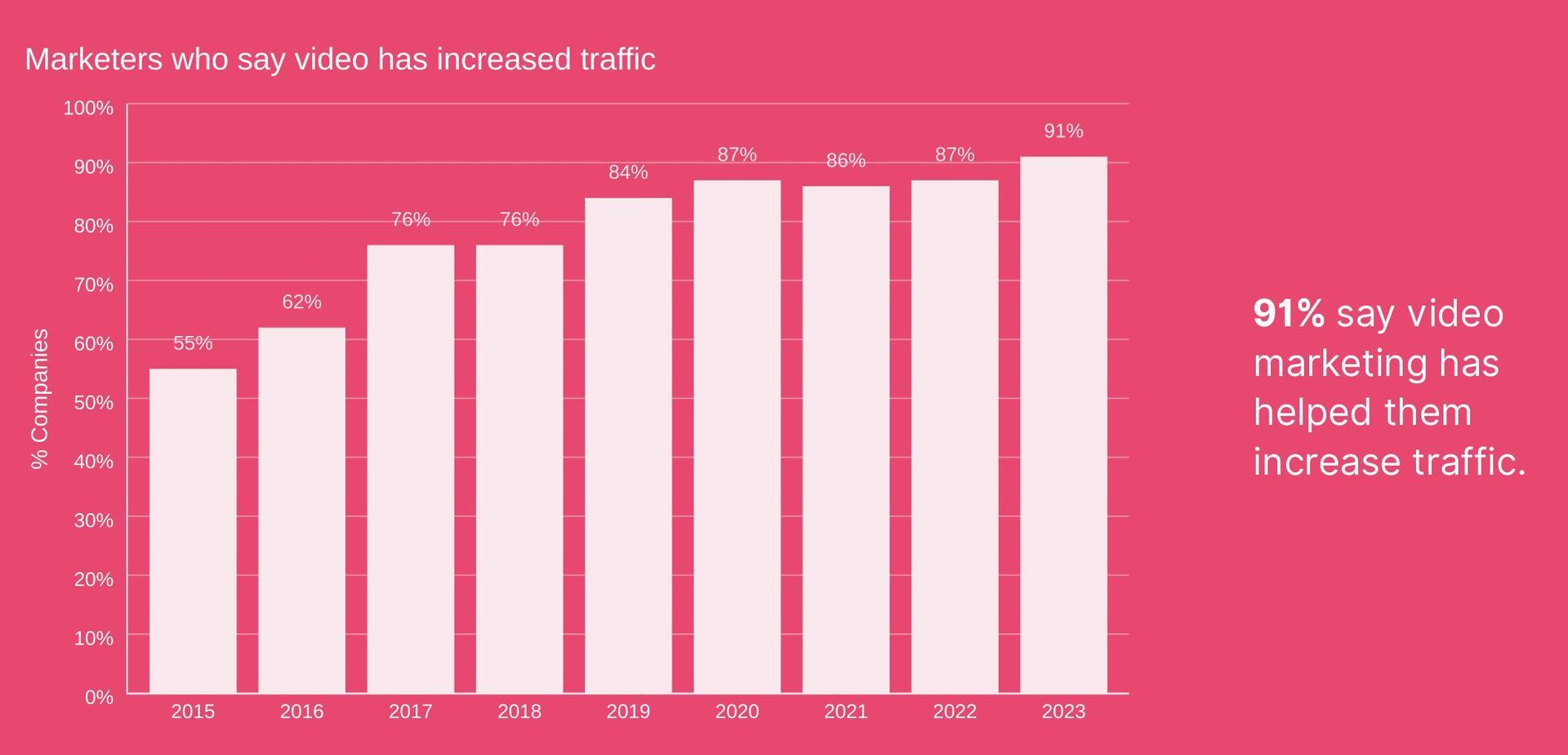
How your videos help your rankings
Did you know that websites with video content perform exceptionally well on search engines? It's true!
Search engines prioritize websites that engage users, provide valuable answers to their questions, and deliver a positive overall experience. And that's where videos come in!
Videos can skyrocket your click-through rates, driving a whopping 157% increase in organic traffic from search engine results pages (SERPs).
Not only that, but videos can also keep users hooked. They're more likely to spend over twice as long on your page as those without videos. This lowers your bounce rates.
But that's not all -
Videos are also powerful tools for building quality backlinks. They are more likely to be shared and linked to by others when your content is high quality.
So, if you want to raise your SEO game, it's time to harness the incredible power of videos.
Ways to improve your site SEO through video content:
- Create engaging, shareable videos with valuable content.
- Optimize video titles, descriptions, and thumbnails with relevant keywords.
- Provide transcriptions or captions for better SEO and accessibility.
- Host videos on your website to increase engagement and reduce bounce rates.
- Share videos on social media to expand visibility and gain backlinks.
- Add video schema markup to enhance search engine understanding.
- Monitor video performance and optimize your strategy accordingly.
Create Engaging Video Content
Craft videos that are informative, engaging, and shareable. Focus on delivering value to your target audience and addressing their pain points. High-quality videos are more likely to be shared, linked to, and ranked higher in search results.
Optimize Video Titles and Descriptions
Use relevant keywords in your video titles and descriptions to make it easier for search engines to understand and rank your content. Be sure to write compelling, accurate descriptions that entice viewers to click on your video.
Transcribe Your Videos
Providing transcriptions or captions for your videos can help search engines understand the content of your videos better. This can also make your videos more accessible to viewers with hearing impairments, improving user experience and SEO.
Host Videos on Your Website
Embedding videos directly on your website rather than relying solely on third-party platforms can improve your website's SEO. This increases visitors' time on your site, reduces bounce rates, and signals to search engines that your content is valuable and engaging.
Share Videos on Social Media
Leveraging social media platforms to share your videos can increase their visibility and reach. This can lead to more engagement, shares, and backlinks, positively impacting your website's SEO.
Optimize Video Thumbnails
Thumbnails are the small preview images viewers see before clicking on a video. Optimize your video thumbnails with eye-catching images, relevant text, and branding to encourage more clicks and views.
Include Video Schema Markup
Adding video schema markup to your website's HTML code can help search engines better understand your videos' content, duration, and other relevant information. This can enhance your website's SEO and increase the likelihood of appearing in rich snippets on search results pages.
Monitor Video Performance
Regularly review and analyze your video metrics, such as views, engagement, and shares. This can provide insights into what resonates with your audience and help you optimize your video marketing strategy for better SEO results.
Incorporating video marketing into your SEO strategy is like adding a turbo boost to your website's visibility, engagement, and performance on search engines.
With awesome videos that grab attention, are optimized for search, and are promoted like a pro, you'll drive loads of organic traffic to your site in no time.
But wait, you still have some more ground to cover. And it's about to get even more exciting!

III. Choose the right video type for your brand’s message and audience
So - you're about to create an actual video! But hold on just a moment... video content creation is more challenging than it looks.
There are different types and styles of videos, each with advantages and disadvantages. Some may align better with your marketing goals. Others may be more budget-friendly in the long run.
Don't worry if you're not sure about the differences - you're not alone!
We're here to break down some of the most common types and styles of videos so you can kickstart the video creation process confidently.
Types of videos
When it comes to video marketing, there are several types of videos that you can leverage to achieve your marketing goals. Here are some of them:
1.Explainer Videos
Explainer videos are video marketing content that uses animations or graphics to simplify complex concepts and explain a product, service, or idea concisely and engagingly.
They are typically short and visually appealing, with a clear, compelling narrative that captures the viewer's attention.
For example, a software company may create an explainer video showcasing how their app works.
Explainer videos often introduce a new product or service, highlight its features and benefits, and address potential customer pain points.
They can be used on websites, social media, email campaigns, and sales presentations to communicate significant messages and persuade viewers to take action effectively.
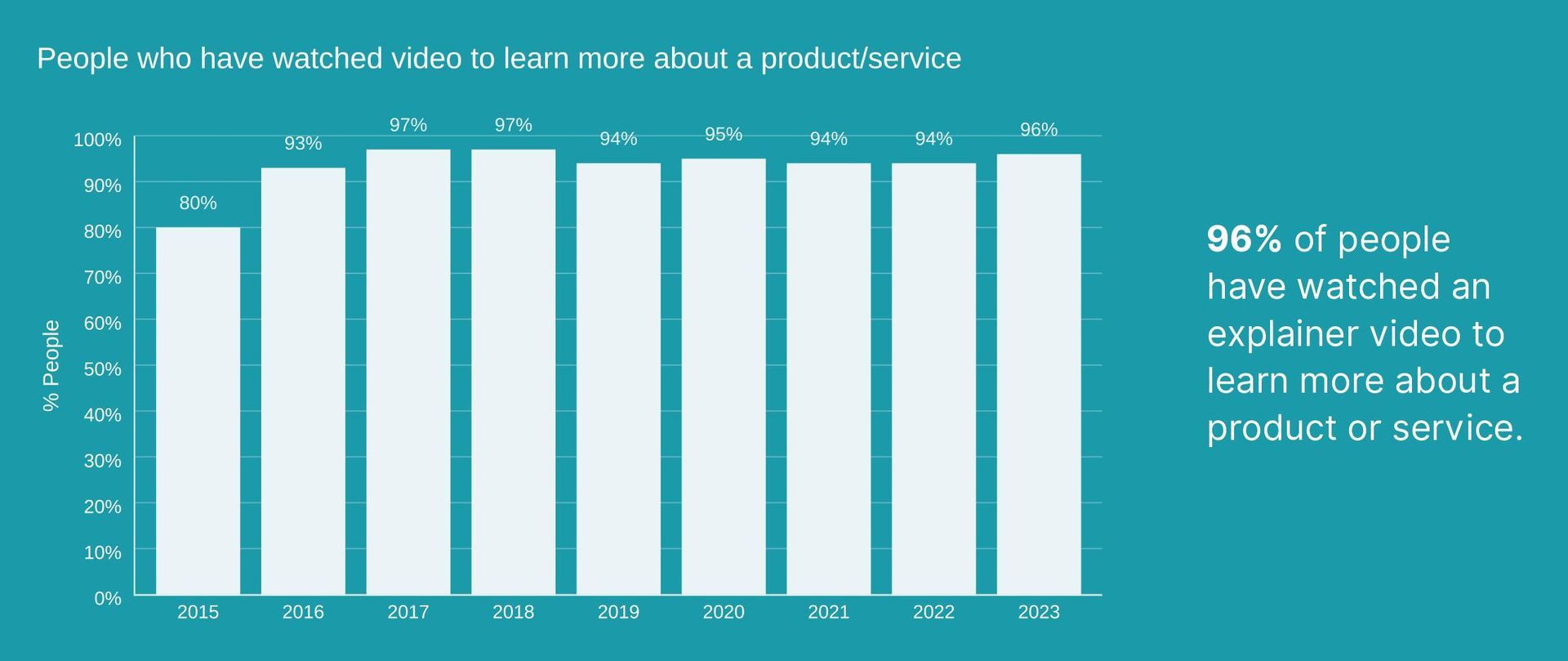
2. Social Media Videos
Social media videos are all about creating eye-catching and engaging content designed for social media platforms. They can be short clips, stories, or longer videos optimized for social media.
You can cover a wide range of topics such as promotions, educational content, behind-the-scenes glimpses, interviews, testimonials, and entertaining videos.
A restaurant, for instance, might create social media videos to flex their masterpiece dishes. Or they could offer exclusive discounts for their followers.
The key to effective social media videos is making them visually appealing, concise, and in line with the best practices of each platform.
You need to capture attention quickly, even when viewed without sound. These videos convey the intended message or story in a way that's compatible with the short attention span of social media users.
Social media videos are a fantastic way for businesses and individuals to:
- build brand awareness
- connect with their audience
- drive traffic to their websites or landing pages
- convert viewers into customers or followers
Such videos can be easily shared, liked, and commented on, allowing for wider reach and increased visibility across social media platforms.
According to YouTube, mobile video consumption rises by 100% annually, indicating the growing popularity of video content on mobile devices.
3. Product Videos
These videos promote a product or service, highlighting its features, benefits, and value proposition. They are focused on demonstrating how the product or service solves a customer's problem or fulfills a need.
For instance, an e-commerce business may create product videos demonstrating how to use a kitchen gadget or showcase different outfits suited to their audience.
Product videos can be created in various styles, such as demonstrations, testimonials, or lifestyle videos. They are commonly used on websites, social media, email campaigns, and online marketplaces.
Product videos are an effective way to showcase the unique selling points of a product, create excitement and interest, and persuade viewers to take action, making them valuable assets in the video marketing toolkit.
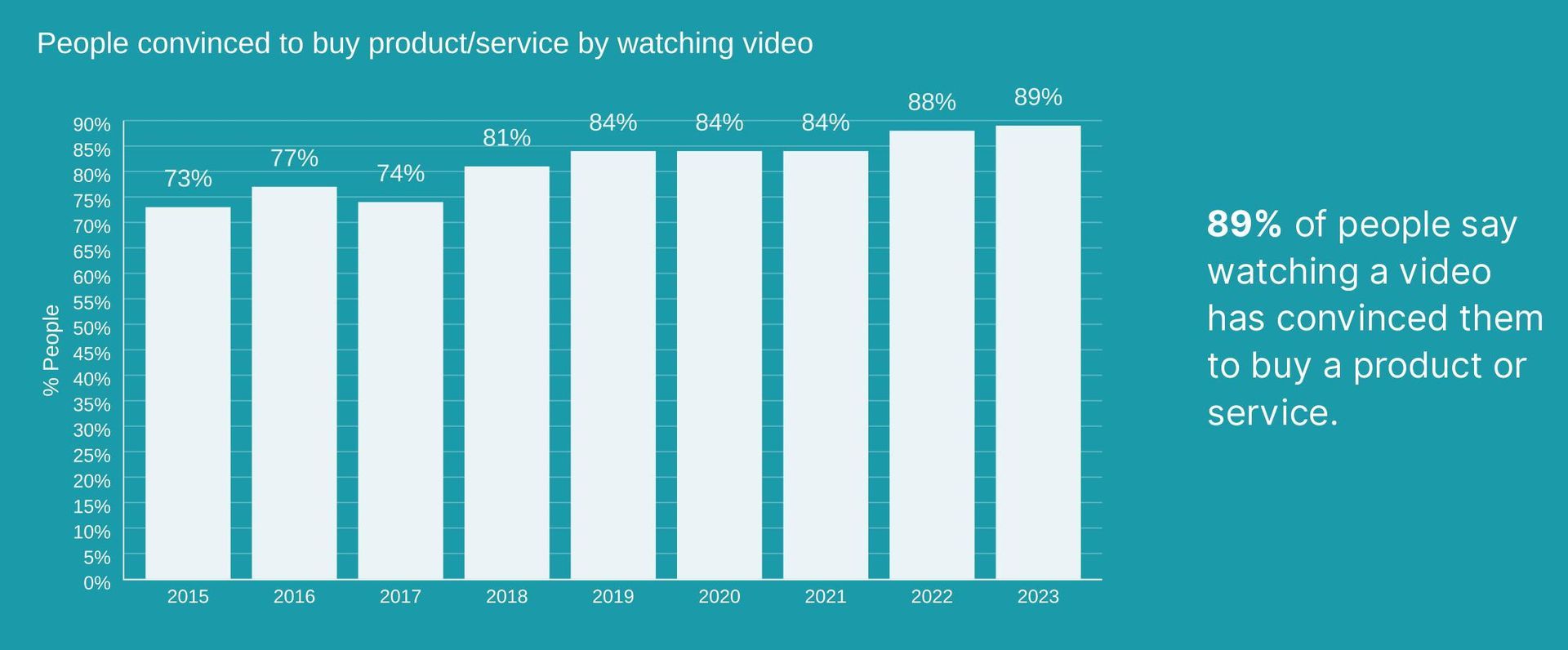
4. Tutorial or How-To Videos
Tutorial or how-to videos are a style of video content that provides step-by-step instructions or demonstrations on how to accomplish a specific task or learn a new skill.
These videos are designed to educate and engage viewers, providing them with actionable information and guidance to achieve the desired outcome.
For example, a beauty brand may create tutorial videos featuring different makeup looks or hairstyles using their products.
Tutorial or how-to videos can cover a range of topics, such as cooking recipes, DIY projects, beauty tips, software tutorials, fitness routines, and more. They can be created in various formats, including screen recordings, live demonstrations, animations, or a combination of different visual elements.

5. Testimonial Videos
These videos are content that features real customers or clients sharing their experiences and feedback about a product, service, or brand. They usually highlight the positive aspects of the offering and are used for the following:
a. Credibility and Trust
Hearing real people share their positive experiences and satisfaction can create a sense of authenticity and reliability, influencing others to trust the brand or product.
b. Social Proof
When potential customers see others who have had positive experiences, they may be more inclined to believe that the product or service is legitimate and worth trying.
c. Emotional Connection
This emotional connection can evoke empathy and resonate with potential customers, increasing engagement and interest in the product or service.
d. Increased Conversion Rates
Testimonial videos can boost conversion rates by providing real-world examples of how the product or service has positively impacted customers' lives. Positive testimonials can influence potential customers to take action, such as making a purchase or contacting the brand for more information.
e. Brand Advocacy
Testimonial videos encourage customers to share their testimonials on social media or through word-of-mouth, increasing brand awareness and potential customer referrals.
f. Versatility
Testimonial videos can be used across various marketing channels, such as websites, social media platforms, email campaigns, and presentations.
They can be repurposed in different formats, such as snippets for social media posts, quotes for testimonials sections on websites, or longer videos for email campaigns, making them versatile and adaptable for different marketing strategies.
For instance, a fitness center may create testimonial videos featuring members sharing their success stories and how the gym has helped them achieve their fitness goals.
Testimonial videos should be well-edited, visually appealing, and convey a sense of authenticity. They should focus on the benefits and outcomes that the customers have experienced and highlight how the product or service has positively impacted their lives or businesses.
6. Brand Story Videos
Brand story videos are captivating forms of video content that convey the unique narrative of a brand. They delve into a brand's history, values, mission, and USP to forge an emotional connection with the audience.
Brand story videos can take different forms, such as live-action narratives, animations, or a blend of visual elements. These may include testimonials, interviews with founders or team members, behind-the-scenes footage, and other creative storytelling techniques.
For example, a sustainability-focused company may create a brand story video highlighting its eco-friendly practices and environmental commitment.
To be effective, brand story videos should be authentic, emotionally resonant, and aligned with the brand's identity.
7. Live Videos
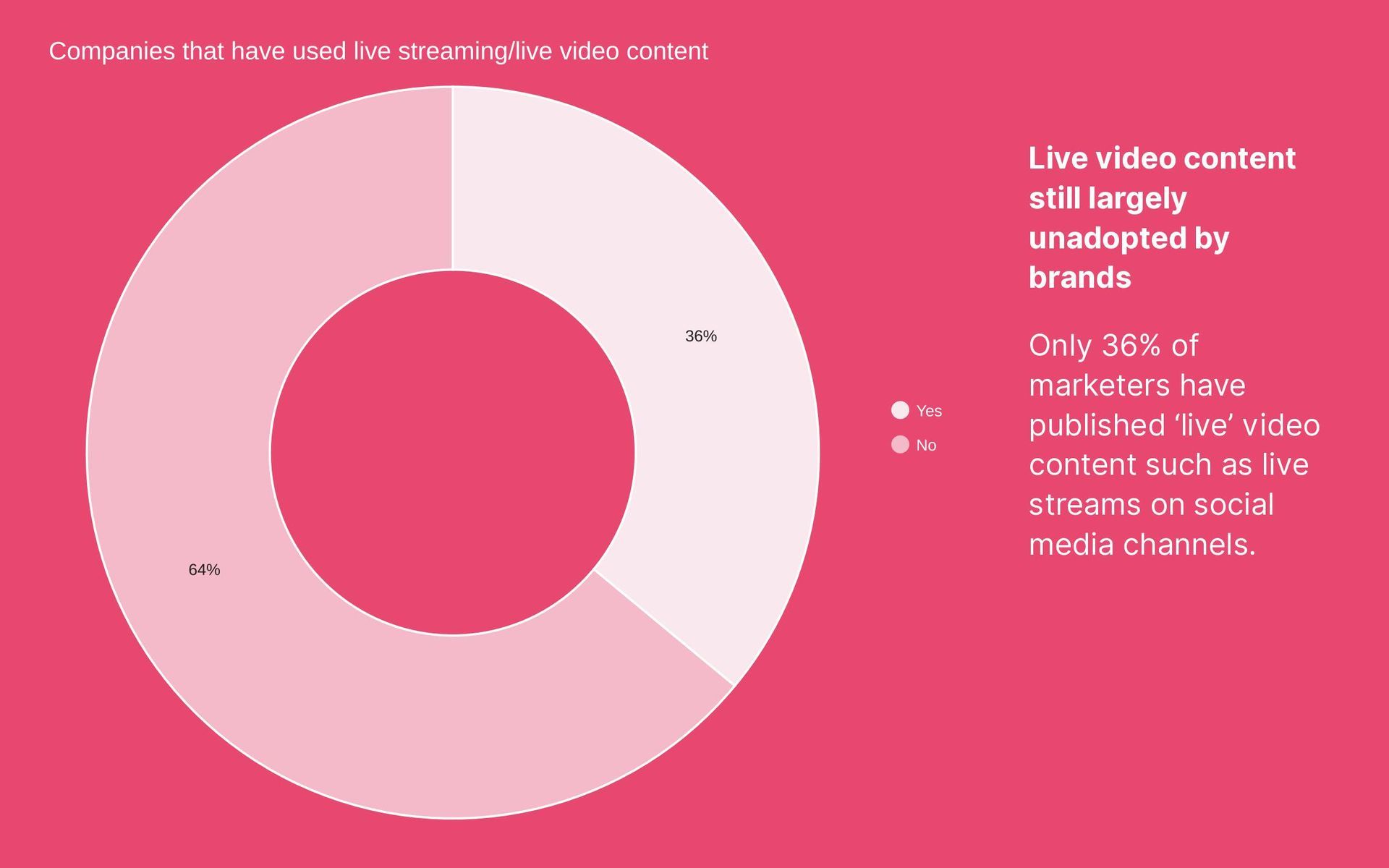
Live videos are an engaging and interactive form of video content where brands or individuals can connect with their audience in real time.
Live videos allow for real-time interactions, such as comments, questions, and reactions, creating a sense of immediacy and authenticity. They can be used for a variety of purposes, including:
- product launches
- Q&A sessions
- behind-the-scenes glimpses
- events coverage
- Interviews
- Tutorials
For example, a fashion brand may host a live video event showcasing its latest collection and allowing viewers to ask questions in real time.
Did you know? Shorter videos are often more effective in engaging viewers and driving shares. According to a study by HubSpot, videos that are 60 seconds or shorter tend to perform better in engagement and shareability. So when it comes to successful video marketing, remember that sometimes, less is more.
IV. Navigate the three key stages of video production
Similar to the three acts of a blockbuster movie, creating an effective piece of video marketing involves three epic stages that will take you (and, ultimately, your audience) on a thrilling ride. From concept to creation to final cut, it's a rollercoaster of creativity, teamwork, and magic.
These three stages of video content creation are pre-production, production, and post-production.
Each stage plays a critical role in the crafting process of a high-quality video that effectively communicates the intended message to the audience.
From planning and preparation to capturing footage and adding finishing touches, each contributes to a video project's overall success.
Let's take a closer look and explore their significance in creating compelling and engaging video content.
Stage 1: Pre-production
Before the cameras start rolling and the action begins, there's a pivotal stage in video production called pre-production.
It's like laying the groundwork for the entire video project. It's when the creative vision is shaped, and all the planning and organizing happen to ensure everything runs smoothly when filming starts.
Think of it as the behind-the-scenes work that sets the stage for a successful video production.
Some key elements of the pre-production stage include:
- Concept Development: This involves defining the video's purpose, message, and target audience. It also includes brainstorming ideas, creating a script or storyboard, and planning the visual and audio elements of the video.
- Budgeting and Scheduling: Determining the budget and timeline for the video production is crucial. This includes estimating costs, securing funding, and creating a production schedule to ensure that all aspects of the project are well-planned and executed within the allocated resources and timeline.
- Location Scouting and Set Design: Identifying and securing suitable locations for filming, as well as designing sets or staging areas, if necessary.
- Casting and Talent Acquisition: Selecting and hiring actors or on-screen talent, if needed, and coordinating their schedules for the production.
- Crew and Equipment Coordination: Assembling the necessary crew, such as the director, cinematographer, sound engineer, and other production personnel, as well as acquiring and organizing the required equipment for the shoot.
- Permissions: Obtaining necessary permits or permissions for filming in certain locations or using copyrighted materials, as well as ensuring compliance with legal and regulatory requirements.
- Production Design: Planning and coordinating the visual elements of the video, such as costumes, props, makeup, and set dressing, to create the desired aesthetic and atmosphere.
- Risk Assessment and Safety Planning: Identifying potential risks and hazards associated with the production and implementing appropriate safety measures to ensure the well-being of the crew, cast, and any other individuals involved in the production.
From choosing the perfect locations and props to casting the right actors or finding unique camera angles, pre-production is where the magic of imagination meets the practicality of planning.
In short, it's where the creative sparks fly.

Stage 2: Production
So, now we're getting to the actual fun part - the production stage in video marketing! This is where all the planning and prep work pays off as we start filming or recording the actual video.
It's also when the creative ideas come to life through visuals and audio, following the script or storyboard.
Think lights, camera, and action - it's time to capture some amazing footage!
Here are some important aspects of the production stage in video marketing:
- Filming or Recording: This is the primary activity during the production stage, where the scenes, shots, and sequences planned during pre-production are captured on camera or recorded using appropriate equipment and techniques.
- Managing Crew and Talent: The production team manages the crew, actors, and other talent involved in the video shoot, ensuring everyone is coordinated, organized, and working together to achieve the production goals.
- Directing and Coaching: The director guides the actors, crew, and other participants to bring the creative vision to life. This may involve giving instructions on performances, camera angles, lighting, and other elements to ensure the desired outcome.
- Monitoring and Troubleshooting: Production constantly monitors various aspects, such as sound, lighting, framing, and performance, to ensure everything is on track. Troubleshooting and problem-solving may be necessary to address any issues or challenges during the shoot.
- Capturing B-Roll and Additional Footage: Apart from the main scenes or shots, additional footage or B-roll may be captured during production to provide context, visual variety, or supplementary content for the final video.
- Adhering to Timelines and Budgets: Production must be managed efficiently to stay within the allocated time and budget constraints, ensuring the video is completed on schedule and within the designated resources.
The production stage is where the creative concepts take shape and come to life through the actual filming or recording process. It requires effective coordination, direction, and management to ensure the video captures the intended message and vision.
In 2005, YouTube's co-founder Jawed Karim uploaded the very first video on the platform, titled "Me at the zoo." It's a short 18-second clip of Karim sharing his thoughts about elephants at the zoo. Little did he know that this humble video would mark the beginning of a video revolution and pave the way for YouTube's immense impact on video sharing, consumption, and marketing in the digital era.
Stage 3: Post-production
After we've captured all the footage, it's time for the post-production stage in video marketing. This is where we transform the raw footage into a polished and cohesive final video. We'll edit the footage, refine the visuals and audio, and add graphics, animations, music, and sound effects to make the video shine.
Now, let's take a closer look at some vital aspects of the post-production stage in video marketing.
These are the key steps that combine all the elements together to create a final video ready to captivate your audience and achieve your marketing goals.
- Video Editing: The raw footage is carefully reviewed and selected to create a cohesive storyline. This includes trimming, rearranging, and combining shots to create the desired flow and pace of the video. Transitions, visual effects, and color correction may also be applied during editing.
- Graphics and Animations: Graphics, animations, and text elements may be added to the video to reinforce the branding, convey information, or enhance visual appeal. This could include lower thirds, titles, captions, and other visual elements.
- Audio Editing: The audio elements, such as dialogue, voice-over, and sound effects, are edited to ensure clear and balanced audio quality. Background music or other audio enhancements may also be added during post-production.
- Music and Sound Effects: Music and sound effects can greatly impact the mood and tone of the video. During post-production, suitable music and sound effects may be selected and added to enhance the overall audio experience of the video.
- Color Correction and Grading: Color correction and grading ensure consistent and visually appealing colors throughout the video. This process can improve the mood, tone, and visual aesthetic of the video.
- Review and Feedback: After the initial editing and enhancements, the video may go through review and feedback cycles with stakeholders to ensure it aligns with the intended message and vision.
- Exporting and Delivery: Once the final edits are made, the video is exported into the desired format and resolution for distribution. This could be for online platforms, broadcasts, or other specified delivery methods.
To recap, the post-production stage is where all the video pieces come together to create the final product.
It requires skillful editing, refinement, and attention to detail to ensure the video meets the intended goals and effectively communicates the desired message to the target audience.

V. Maximize reach and engagement through effective video distribution channels
Wow, you've just created a captivating video!
But remember, the real magic happens when your video reaches your target audience.
It's time to roll up your sleeves and get strategic with video distribution.
When distributing your video, you've got three main channels: owned, paid, and earned.
Each has perks and drawbacks, but finding the right balance can work wonders for your video marketing. It's all about spreading your brand awareness and converting users at every marketing funnel stage.
Let's look into each of these channels and explore how they can take your video to new heights!
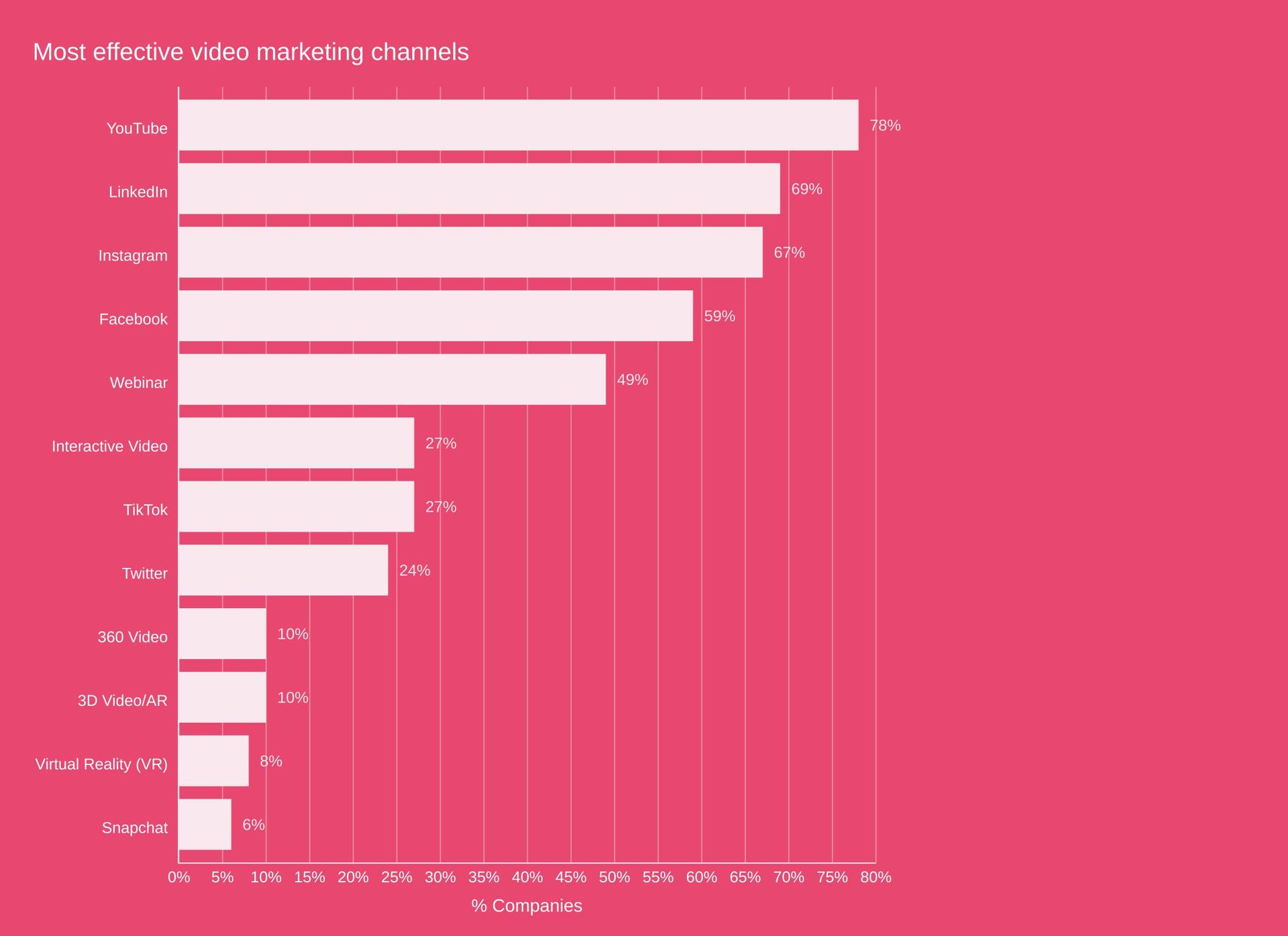
Owned media
Don't forget about your owned channels when it comes to distributing your video.
These are the platforms and channels you own and control, like your website, PDFs, digital docs, email lists, e-commerce pages, apps, and more. They're like your video's inner circle!
Don't leave any of these valuable channels untapped:
1.Website/ blog
You can embed videos directly on your website or blog pages to create engaging visual content that enhances your message or story.
You can use product videos, explainer videos, testimonials, and more. Embedding videos on your website or blog can help you convey your brand message, showcase your products or services, and engage your visitors.
2. Email marketing
Email marketing is a powerful tool for reaching your audience, and incorporating videos into your emails can take your campaigns to the next level.
You can embed videos directly in your newsletters. Or you can use clickable thumbnail images to lead your subscribers to video landing pages.
It's a fun and engaging way to communicate with your audience and boost open rates, click-through rates, and overall engagement.
3.Internal channels
Internal channel video distribution is like having a secret stash of awesome videos only your team can enjoy. It's all about sharing the latest updates, announcements, and training videos using your company's intranet, communication tools, or even a company-wide email blast.
According to LinkedIn, videos are shared 20 times more than other types of content on their platform. But that's not all! LinkedIn video campaigns have shown impressive statistics, with 82% view rates and 90% completion rates, showcasing users' high engagement level with video content on this professional networking site.
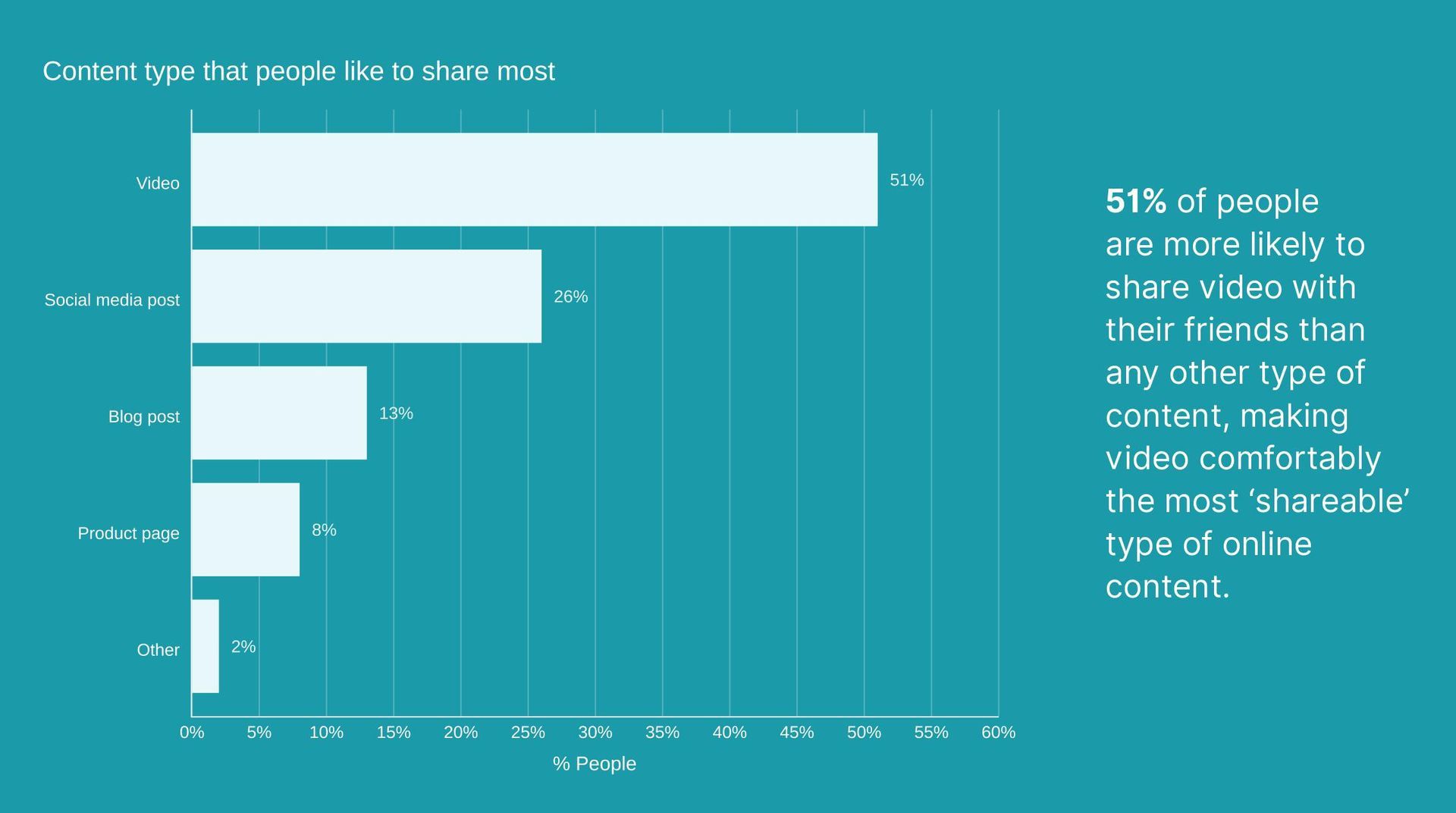
Aiming for a more targeted audience? The next distribution channel will be a great option if you have the budget.
Paid media
Paid distribution is like having a magic wand that can skyrocket your video's reach and impact.
Many online platforms indeed offer free services, but with paid distribution, you can unlock a whole new level of visibility and engagement for your video.
Think of it as an investment in getting your content in front of the right eyeballs. After all, you often have to spend money to make money.
Here are examples of paid distribution channels to get your video the attention it deserves:
1.Influencer
Leveraging the power of influencers can expand your video's reach, tap into new audiences, and leverage the credibility and influence of established content creators.
Partnering with influencers can lead to greater visibility, increased engagement, and higher potential for conversions.
Influencers act as advocates for your video, amplifying its impact and driving more views, likes, shares, and, ultimately, more success for your video marketing campaign.
2. PR
Public relations efforts can help you gain media coverage, generate buzz, and create a positive brand image, which can enhance the visibility and reach of your videos.
PR video distribution channels can include methods such as press releases, media outreach, news distribution services, and influencer collaborations. These channels can help you tap into established media networks and reach a wider audience through news articles, interviews, and other media coverage.
3. Native ads
Native ads are designed to blend in with the surrounding content and provide a non-disruptive advertising experience for viewers. This can effectively reach a wider audience, increase engagement, and drive conversions for your videos.
Native advertising platforms typically offer targeting options that allow you to reach specific demographics, interests, or behaviors. They can help you refine your video distribution strategy and ensure the right people see your videos.
Native ads can be displayed on various websites, social media platforms, and content discovery networks, providing a wide reach for your videos.
Paid video distribution channels offer increased visibility, targeted reach, and fast results. However, they also come with costs, potential ad blindness, ad blocking, and competition.
Careful planning, budget management, and understanding of your target audience are essential to make the most out of paid video distribution efforts.
Meanwhile, you’ll likely get higher credibility at no extra cost when you use this next distribution channel.
Earned media
Earned or free media refers to online platforms or websites where you can upload and share your video content without incurring any cost. These platforms allow you to reach a wide audience, showcase your videos, and promote your brand or message.
Some popular examples of free video distribution channels include:
1.YouTube
YouTube is one of the largest and most popular video-sharing platforms, with billions of users worldwide. You can create a YouTube channel, upload your videos, and share them with your audience. YouTube offers features like video monetization, analytics, and community engagement options.
2. Vimeo
Vimeo is another popular video hosting platform that offers free and paid plans. It provides a sleek and professional interface for hosting, sharing, and embedding videos on websites. Vimeo also offers advanced privacy settings, video analytics, and customization options.
3. Social Media
Many social media platforms, such as Facebook, Instagram, Twitter, and LinkedIn, allow you to upload and share videos for free. You can leverage these platforms to reach your followers, engage with your audience, and promote your videos organically.
4. Video Sharing Communities
Some various online communities and forums focus on video content sharing, such as Reddit, TikTok, and Snapchat. These communities allow you to share your videos with like-minded users and gain more visibility and engagement.
Note that even examples of paid media can also be earned media such as influencer marketing and PR.
5. PR efforts
PR activities, such as press releases, media outreach, or media partnerships, can generate earned media coverage for your video content.
Media outlets or journalists can pick up and share your video as part of their news or editorial content. It can result in organic visibility and reach among their audience, without the need for paid promotion.
This earned media coverage can amplify your video's exposure and credibility.
6. Influencer collaborations
Collaborating with influencers or content creators who have a genuine following and influence in your niche can result in earned video distribution.
When influencers create and share video content featuring your brand or products with their audience, it can generate organic reach, engagement, and word-of-mouth promotion. Their followers are more likely to trust and engage with the content, as it comes from a trusted source. Consequently, you’ll have earned visibility and potential new followers or customers for your video.
Both PR efforts and influencer collaborations can help your video content gain organic traction and visibility among relevant audiences, without requiring paid advertising.
However, it's important to note that these earned distribution channels along with other examples, may require building relationships, outreach, and negotiation efforts. Their success depends on the relevance and credibility of your video content, as well as the influence and engagement of the PR outlets or influencers you collaborate with.

Things you should remember about using earned media
Earned video distribution can be challenging but rewarding, as it relies on organic and uncontrollable viewer sharing.
While it may seem like leaving your distribution up to chance, there are substantial efforts you can make to tilt the odds in your favor. The best part is that earned media is completely free to implement, requiring only your efforts and willingness to follow up.
Despite its unpredictable nature, there are several strategies you can employ to boost your earned distribution efforts.
So, here are a few tips to boost your earned distribution efforts:
- Create awesome content
It all starts with creating high-quality, engaging videos that your target audience will love. When your content is compelling, people are more likely to share it with friends and followers.
- Team up with influencers
Partner with influencers or brand advocates who align with your brand and can help spread the word about your videos. Their endorsement can go a long way in generating organic shares and wider distribution.
- Engage with your audience
Interact with your audience on social media, respond to comments, and encourage them to share your videos. Building a community around your content can lead to more organic sharing and word-of-mouth promotion.
- Optimize your video SEO
Use relevant keywords, add meta tags, and optimize your video titles and descriptions to improve your videos' visibility in search results. This can increase the chances of your videos being shared organically.
- Share on social media and email
Share your videos on social media platforms and leverage your email list to promote them. Encourage your followers and subscribers to share your videos with their networks, which can help amplify your earned distribution efforts.
Remember, earned media may require some luck, but with strategic efforts, you can increase the chances of sharing your videos and gaining wider visibility.
So, don't hesitate to put in the effort and follow up on opportunities to enhance your earned video distribution game.
Fun fact: Facebook generates a staggering 8 billion video views every day. That's a massive audience for video distribution! With its extensive user base and powerful video features, Facebook has become an excellent platform for businesses and marketers to connect with their target audience through engaging video content.

VI. Evaluate the performance and effectiveness of your video content
Now that you've put in all the hard work to create and release your video, the next big question is: how is your target audience responding to it? What kind of impact is it making? Are you seeing the results you were hoping for after implementing all the necessary elements?
Anticipate and analyze your audience's reaction, as their feedback and engagement will reveal the true success of your video and help you further refine your marketing strategy.
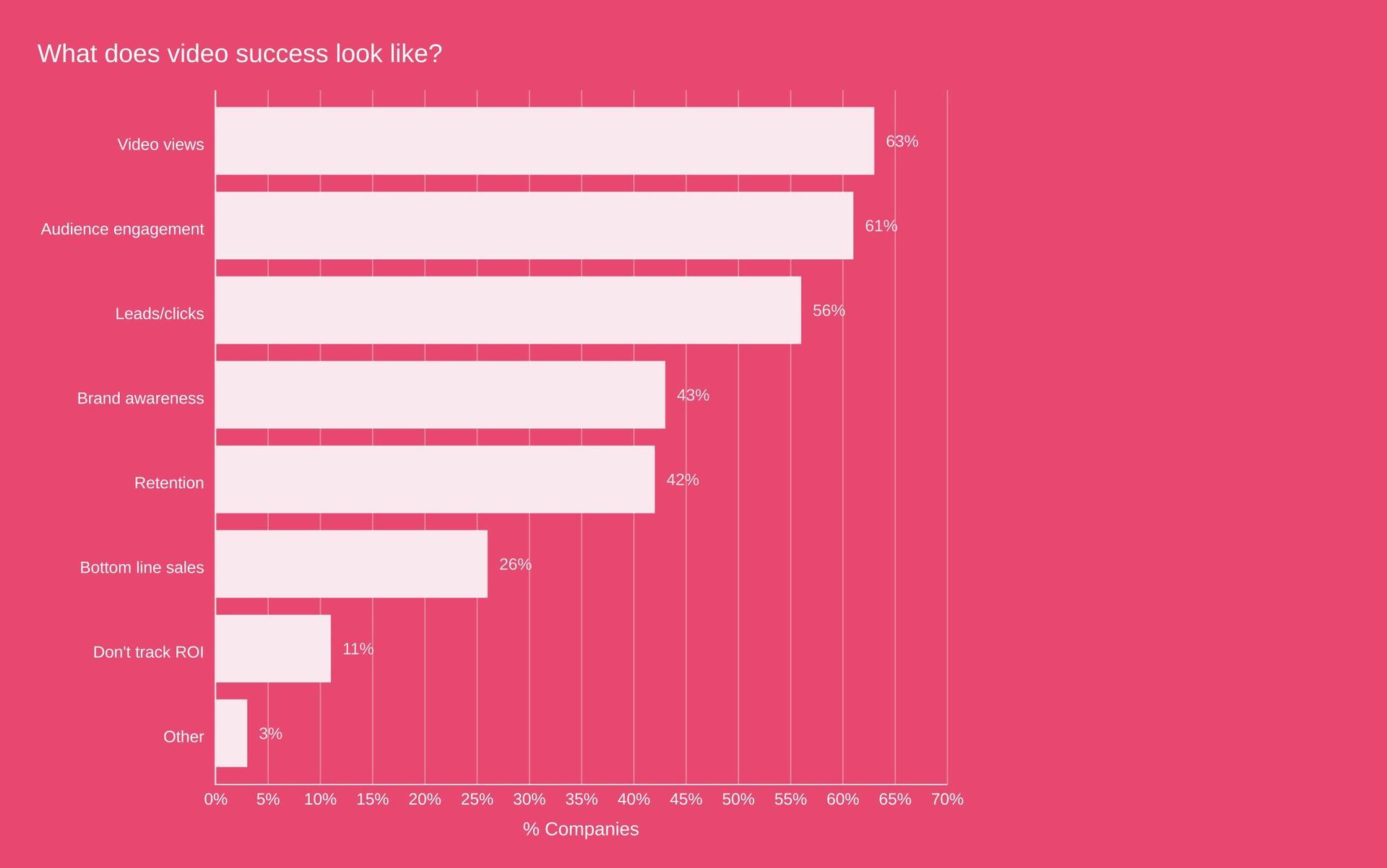
The most effective approach is prioritizing metrics defining success.
While viral videos with high view counts may seem impressive, we value videos that deliver tangible results above all else.
It's easy to get caught up in the allure of a high impression count, but we urge you to adopt a results-driven mindset.
By focusing on the metrics that align with your video goals and can drive meaningful outcomes, you can avoid being blinded by view counts alone. Instead, understand how specific metrics translate into video success, such as increased sales and conversions.
Prioritizing the right metrics will enable you to achieve not just high view counts, but also tangible business outcomes that truly matter.
Here are several methods to evaluate the success of your video marketing:
1.Viewership Metrics
You can track metrics such as views, watch time, and engagement (likes, comments, shares) to assess the reach and engagement of your video content.
Higher views, longer watch time, and increased engagement generally indicate that your videos resonate with your target audience.
Here are commonly used metrics:
a. Views
These refer to the number of times your video has been seen by unique users. This metric gives you an idea of the overall reach of your video. For example, if your video has 10,000 views, it means it has been viewed 10,000 times by unique users.
b. Watch Time
The total amount of time users have spent watching your video. This metric indicates how engaging your video is and whether users are watching it until the end.
c. Engagement Metrics
These metrics include likes, comments, shares, and other user interactions with your video. Likes indicate how well-received your video is, while comments provide insights into user feedback. Shares reflect the extent to which users send your video to other people in their network.
So if your video has 500 likes, 50 comments, and 100 shares, it indicates a high level of engagement.
d. Audience Retention
This metric measures how long viewers are staying engaged with your video. It provides insights into when users drop off or stop watching your video.
For example, if your video has a 50% audience retention rate at the 2-minute mark, 50% of viewers continued watching until the 2-minute mark, while the other 50% dropped off.
e. Play Rate
The percentage of users who clicked the play button after landing on the video page. This metric indicates how well your video entices users to start watching it.
If your video has a play rate of 30%, it means that 30% of users who landed on the video page clicked the play button.
f. Click-through Rate (CTR)
The percentage of users who clicked on a call-to-action (CTA) or other links within your video. This metric measures the effectiveness of your video in driving users to take action.
These are just some examples of viewership metrics that can help you assess the performance and engagement of your video content. It's important to track these metrics regularly, analyze the data, and use the insights to optimize your video marketing strategy and create more engaging and effective videos.
2. Conversions and Sales
If your video marketing is aimed at driving specific actions, such as conversions or sales, you can track those metrics to determine the success of your efforts.
For example, you can measure the number of leads generated, sales made, or other conversion actions taken due to your videos.
Sales and conversions are key metrics in video marketing that indicate how well your videos drive desired actions from your audience.
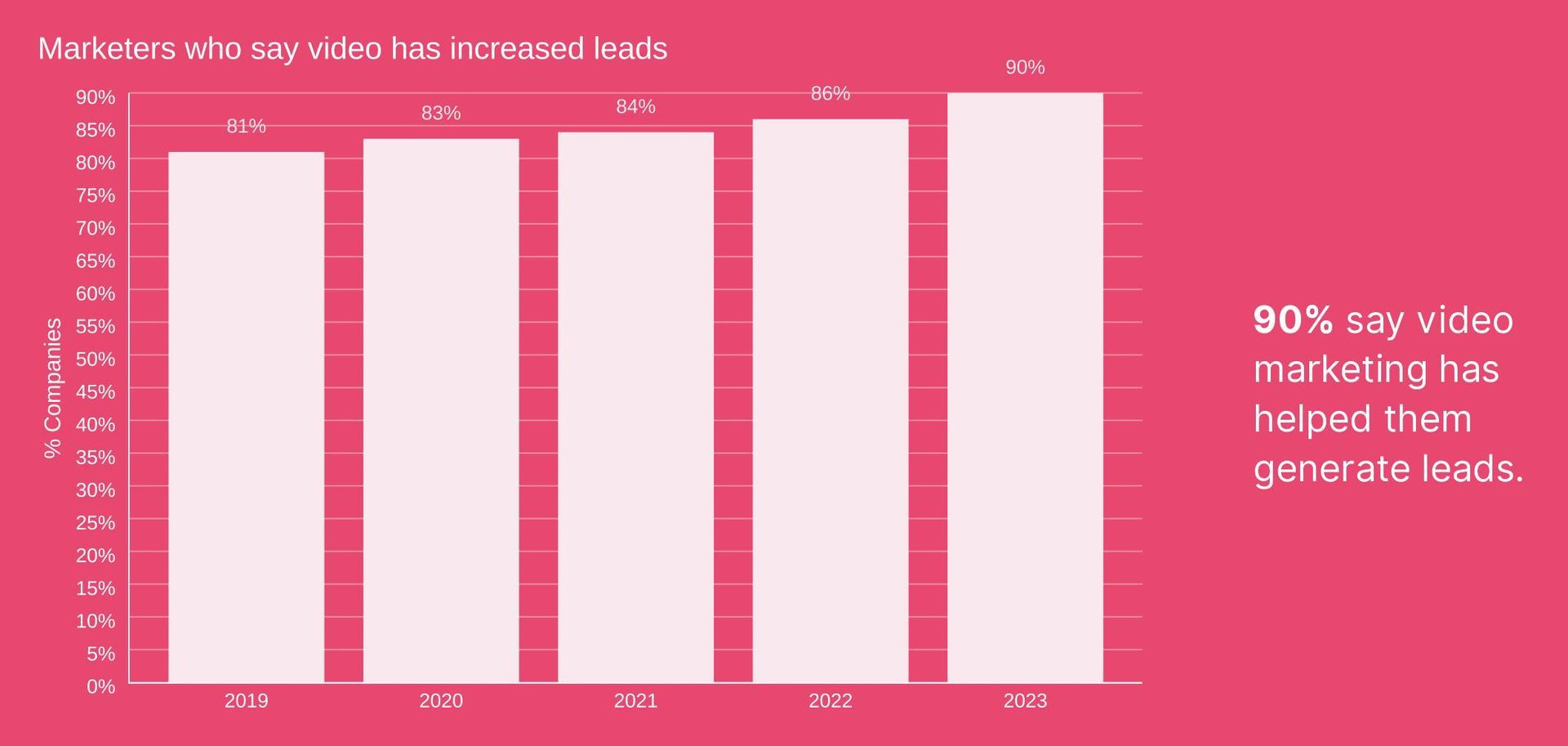
Sales refer to the actual monetary transactions or purchases that result from your video marketing efforts.
For instance, if you create a product video showcasing the features and benefits of a new product, and viewers purchase directly from the video, those purchases would be considered sales attributed to your video.
Interesting find: Landing pages with videos can increase conversions by up to 80%, according to a study by Unbounce.
How do you track sales and conversions?
Sales can also be tracked through unique promo codes or affiliate links mentioned in your video that drive viewers to purchase on your website or through an e-commerce platform.
Let's say you run an e-commerce store selling fitness equipment and create a video showcasing your latest treadmill model. In the video, you highlight the treadmill's features, show it in action, and provide a compelling call-to-action for viewers to purchase the treadmill with a special promo code. If viewers use the promo code and purchase, those sales can be directly attributed to the video.
Conversions refer to the desired actions you want viewers to take after watching your video, which may not necessarily result in immediate sales.
Conversions could include:
- Signing up for a newsletter
- Filling out a form
- Downloading a whitepaper
- Subscribing to a service
Conversions are typically tracked through specific landing pages, forms, or tracking pixels associated with your video content.
Let's say you create a video promoting a free webinar on digital marketing strategies for small businesses. In the video, you provide valuable insights and encourage viewers to sign up for the webinar by visiting a landing page and filling out a form. If viewers visit the landing page, fill out the form, and register for the webinar, those registrations would be considered conversions attributed to the video.
In both examples, sales and conversions are important metrics that indicate the effectiveness of your video marketing efforts in driving desired actions from your audience.
By tracking and analyzing these metrics, you can gain insights into how well your videos drive sales and conversions and make data-driven decisions to optimize your video marketing strategy for better results.
3. Brand Awareness and Recall
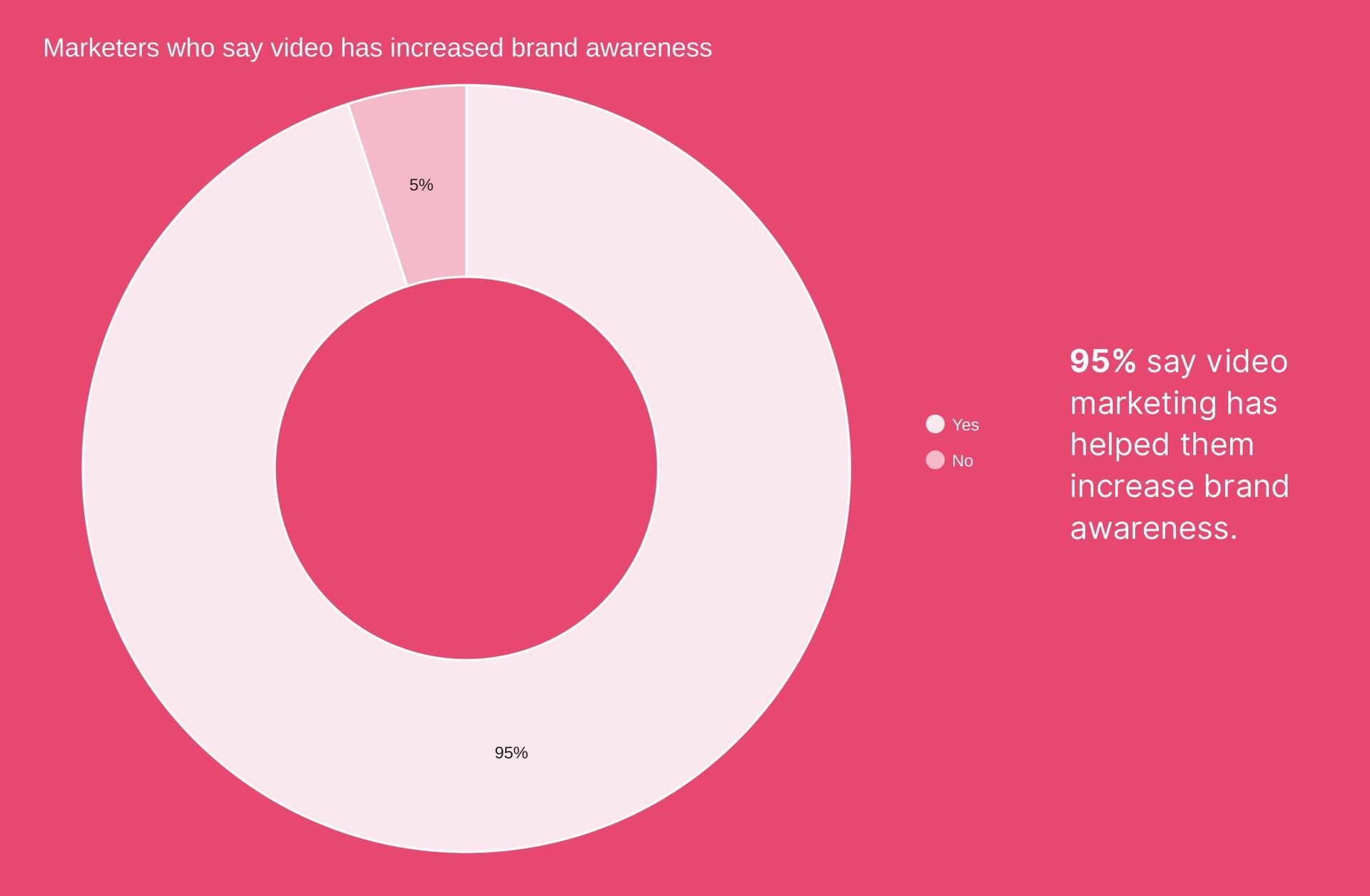
Assessing brand awareness and recall can be done through surveys or tracking brand mentions and sentiment on social media.
It can be considered a success if your videos effectively increase brand awareness or recall.
Brand awareness and recall are key metrics for measuring the success of video marketing campaigns. They help determine how well your videos create awareness about your brand and whether viewers can recall your brand after watching them.
How do you measure brand awareness and recall?
Brand awareness can be measured through various methods, such as surveys, social media mentions, website traffic, and search volume related to your brand.
Let's say you're a new startup specializing in sustainable fashion, and you create a series of videos showcasing your products, manufacturing processes, and commitment to sustainability. 4
After running your video marketing campaign, you can measure brand awareness by conducting surveys to assess how many viewers recall your brand name, associate it with sustainable fashion, or recognize your brand logo.

According to a Google study, 70% of YouTube users say they have made purchase decisions based on videos they've seen on the platform.
Brand recall refers to the ability of viewers to remember and recall your brand after watching your videos. It indicates how memorable your brand is in the minds of your audience and whether your videos are effectively creating a lasting impression.
Brand recall can be measured through surveys, recall tests, and by analyzing viewer engagement with your videos, such as likes, comments, and shares.
For example, you might want to create a series of entertaining and humorous videos that showcase the unique features of your mobile app, which offers a personalized fitness coaching program.
You can measure brand recall by conducting surveys or recall tests to assess how well viewers remember your brand name, app features, and value proposition. You can also analyze viewer engagement with your videos, such as comments, likes, and shares, to gauge the level of brand recall.
4. ROI
ROI in video marketing measures the financial return or value generated from the investment in creating and promoting videos. It takes into account the costs associated with producing, promoting, and distributing videos and compares them to the outcomes achieved, such as increased sales, conversions, or customer engagement.
You might be interested to know that 92% of businesses surveyed by Wyzowl reported a positive ROI from their video marketing efforts
A positive ROI indicates that the video marketing campaign has generated more value than the investment. In contrast, a negative ROI indicates that the campaign may not be delivering the desired results.

How do you measure ROI?
Here's an example: Let's say you're a software company creating tutorial videos to promote your new software product. You invest in video production, editing, and promotion efforts, including hosting the videos on your website, social media platforms, and YouTube channel.
As a result of your video marketing campaign, you will notice a significant increase in website traffic, product inquiries, and sales of your software product. You can also track the costs associated with video production and promotion, including production expenses, paid advertising, and hosting fees.
To calculate the ROI of your video marketing campaign, you can compare the total value generated from the campaign, such as increased sales revenue or customer acquisitions, to the total investment made in creating and promoting the videos.
If, for example, your video marketing campaign generates $10,000 in increased sales revenue, and the total investment made in video production and promotion is $5,000, your ROI would be calculated as follows:
ROI = (Total Value Generated - Total Investment) / Total Investment
ROI = ($10,000 - $5,000) / $5,000
ROI = 1 or 100%
This indicates that your video marketing campaign has generated a positive ROI of 100%, meaning that for every dollar invested in video production and promotion, you have earned a return of $1. This indicates that your video marketing campaign has successfully delivered tangible results and generated a positive return on investment.
Marketers who use video as part of their content strategy report an average of 49% faster revenue growth compared to those who do not, according to a study by Aberdeen Group.
It's important to note that ROI can be influenced by various factors:
- goals of your video marketing campaign
- costs associated with video production and promotion
- outcomes achieved
It's essential to define clear objectives and track relevant metrics to accurately measure the ROI of your video marketing campaigns and make data-driven decisions to optimize your marketing strategy for better results.
5. Analytics tools
Utilize analytics tools such as YouTube Analytics, Google Analytics, or social media analytics to gather data on your videos' performance. These tools provide insights into various metrics such as views, watch time, engagement, and audience demographics.
These insights can help you understand the performance of your videos and make data-driven decisions.
Data analytics are like a crystal ball that reveals the secrets behind the success of your video marketing campaigns, or like a superpower that helps you unlock valuable insights into viewer behavior - like magic, they enable you to make informed decisions to optimize your strategy.
Heatmaps are a popular video analytics tool that visually represents viewer engagement and interactions with a video, helping marketers identify areas of interest and optimize video content accordingly.
How to use the analytics tool:
Imagine you're a trendy fashion brand that loves to showcase your latest clothing collections through captivating videos on social media and your website. You use data analytics tools to uncover the juicy details behind your videos' performance. You dig deep into metrics like video views, engagement rate, click-through rate, conversion rate, and bounce rate to understand what's working and what's not.
As you dive into the data, you uncover a gem! One particular video featuring your sizzling summer collection received sky-high engagement and conversion rates compared to others.
But, you also spot a red flag - most viewers dropped off within the first 30 seconds. Yikes!
Armed with this valuable insight, you put your thinking cap on and brainstorm ideas to optimize your videos. You decide to spice up the opening of your videos to grab viewers' attention from the get-go.
You also tap into the data from the platforms where your videos are hosted and promoted, like YouTube and social media, to understand your audience's demographics, location, and viewing patterns. This enables you to:
- tailor your content and distribution strategy to target specific audience segments
- optimize thumbnails
- use keywords and tags to boost visibility and engagement.
The best part? You're not flying blind anymore. You have data analytics as your trusty sidekick, helping you make data-driven decisions to fine-tune your video marketing strategy.
You can now confidently measure the success of your video marketing efforts, make informed decisions, and unlock better results. It's like having a secret sauce that turbocharges your marketing game and takes your brand to new heights.
So, with data analytics as your ally, you can unleash the full potential of your video marketing campaigns and make waves in the digital world. It's like wielding a sorcerer's staff. It reveals the secrets to success and empowers you to make your video marketing dreams come true.
Takeaway
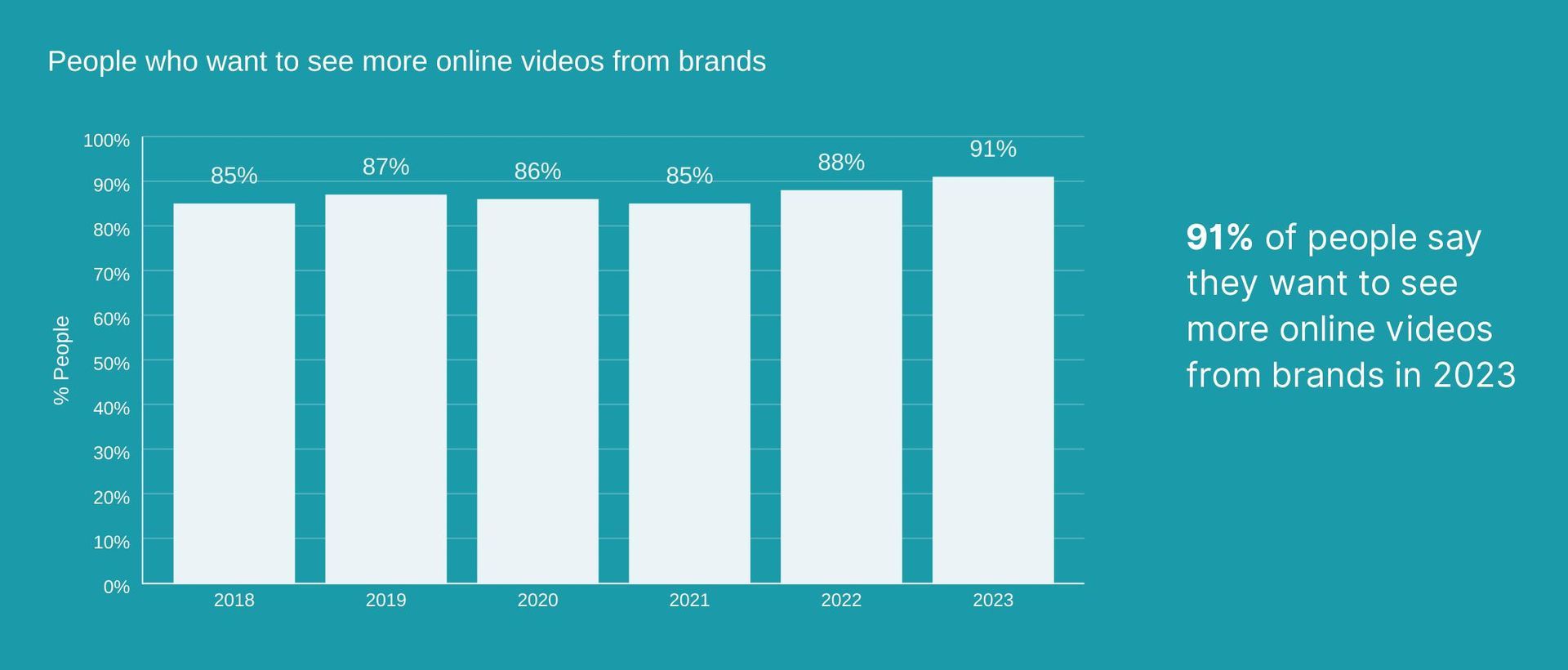
You don't want to miss out on the incredible opportunity video marketing offers for your brand.
Indeed, there is growing love for video content, with platforms giving video top priority and devices being more video-ready than ever. It's the perfect time to connect with your audience in a compelling and engaging way.
Optimizing and adjusting your video content based on data insights allows you to stay ahead of the game.
So why wait? Start leveraging the power of video marketing now and capture those valuable customers.
Embrace the excitement of video marketing and take your brand to new heights of success!


Get total clarity on your video marketing and paid media with our FREE comprehensive data audit.


